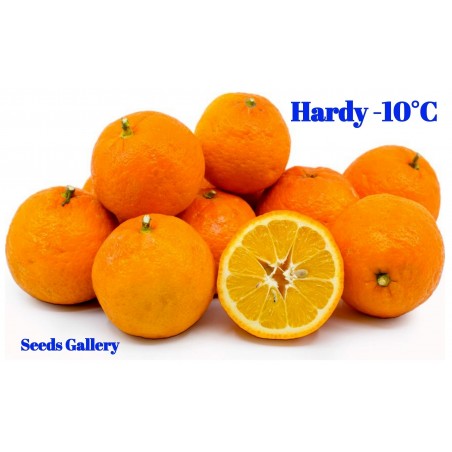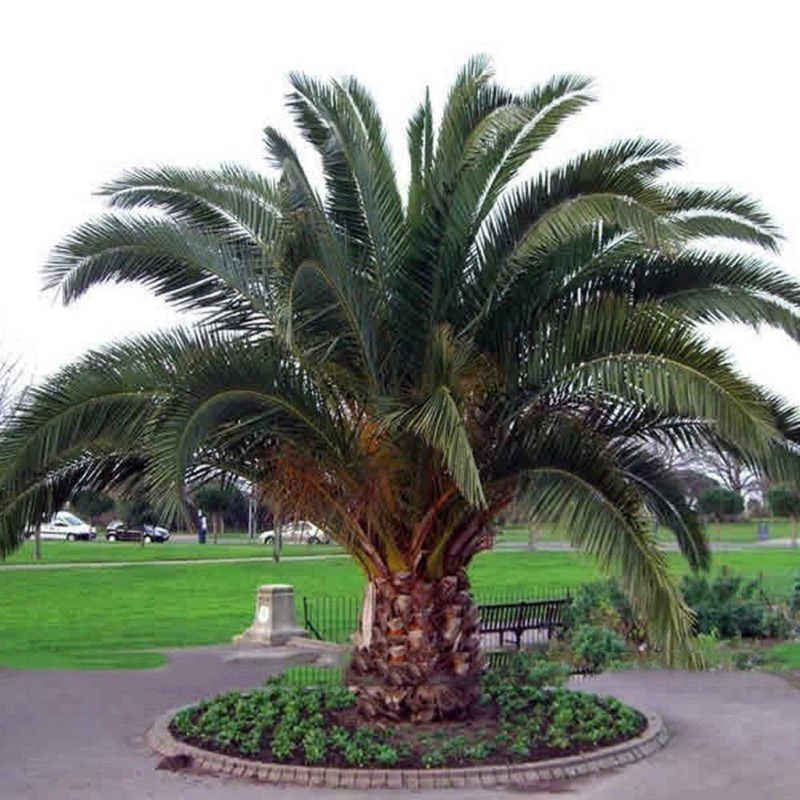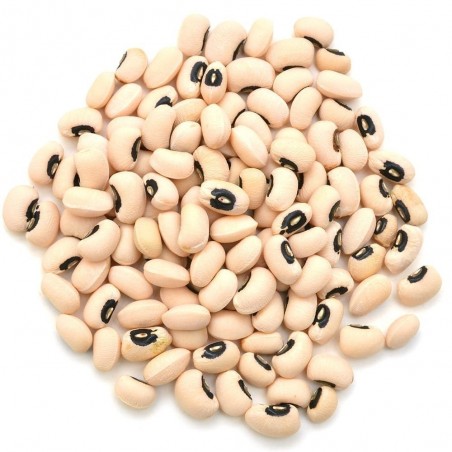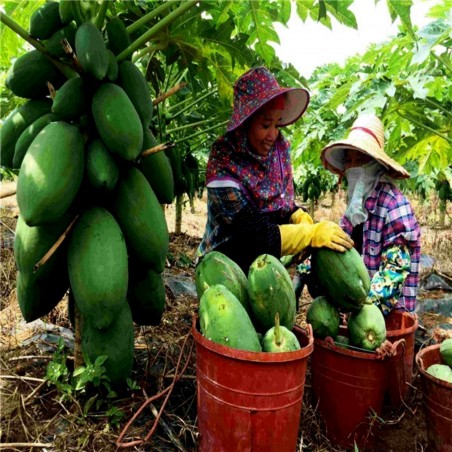
نخلة كنارية بذور
(Phoenix canariensis) نخلة كنارية بذور
ثمن عبوة 10, 50 بذور.
نخلة كنارية الاسم العلمي:Phoenix canariensis هي نوع من النباتات يتبع جنس النخلة من الفصيلة الفوفلية .
(Phoenix canariensis) نخلة كنارية بذور
ثمن عبوة 10, 50 بذور.
نخلة كنارية الاسم العلمي:Phoenix canariensis هي نوع من النباتات يتبع جنس النخلة من الفصيلة الفوفلية .
Phoenix canariensis is a species of flowering plant in the palm family Arecaceae, native to the Canary Islands. It is a relative of Phoenix dactylifera, the true date palm. It is the natural symbol of the Canary Islands, together with the canary Serinus canaria.
Description
Phoenix canariensis is a large solitary palm, 10–20 m (33–66 ft) tall, occasionally growing to 40 m (131 ft). The leaves are pinnate, 4–6 m (13–20 ft) long, with 80–100 leaflets on each side of the central rachis. The fruit is an oval, yellow to orange drupe 2 cm (0.79 in) long and 1 cm (0.39 in) in diameter and containing a single large seed; the fruit pulp is edible but too thin to be worth eating.
Names
The most used common name in English is Canary Island Date Palm. The common name in Spanish speaking countries and in the Canary Islands is palmera canaria. It has sometimes mistakenly been called a pineapple palm but, it is not related to pineapples at all, which are grown low to the ground and not on trees.
Cultivation
The Canary Island date palm is very widely planted as an ornamental plant in warm temperate regions of the world, particularly in areas with Mediterranean climates but also in some areas with a mild oceanic climate, such as Ireland and the Channel Islands.[2] It can be cultivated where temperatures never fall below −10 or −12 °C (14 or 10 °F) for extended periods, although it will require some protection if cold periods are longer than normal.
The palm is easily recognized through its crown of leaves and trunk characteristics. It is not uncommon to see Canary Island date palms pruned and trimmed to enhance the appearance.
When pruned, the bottom of the crown, also called the nut, appears to have a pineapple shape.
It has gained the Royal Horticultural Society's Award of Garden Merit.
Other uses
In the Canary Islands, the sap of this date palm is used to make palm syrup. La Gomera is where most of the sap is produced in the Canary Islands.
Invasiveness
In some mediterranean and subtropical countries, P. canariensis has proven to be an invasive plant. In New Zealand, it has invaded a range of habitats. New Zealand's Landcare Research has classified the palm as a 'sleeper weed' - "a plant that spreads slowly and goes unnoticed until it becomes widespread". It is also considered naturalised in Spain, Italy, Australia, Bermuda and parts of the United States (California, Arizona, Florida and Alabama).[5][6] In Auckland, New Zealand, the palm has itself become a host for the naturalised Australian strangler fig, Ficus macrophylla.
| بذور العضوية؟ | Organic Seeds |
|---|---|
| المعالجة من بذر؟ | إزالة اللب وتنظيف البذور قبل البذر. |
| بذر عمق؟ | انبت البذور في كيس بلاستيكي بمنشفة ورقية |
| نبات معمر؟ | Perennial plant : Yes |
| بذور منتقاة بعناية؟ | Handpicked seeds |
| مقاومة للبرودة والصقيع؟ | Cold resistant: to −15 °C |
| مناسبة للنمو في وعاء الزهور؟ | Suitable for pot: Yes |
| أصل البذور؟ | أصل البذور: البوسنة والهرسك |


Your review appreciation cannot be sent
Report comment
Report sent
Your report cannot be sent
اكتب تعليقك
Review sent
Your review cannot be sent
🌍 الشحن العالمي من الاتحاد الأوروبي
نقوم بالشحن إلى جميع أنحاء العالم من الاتحاد الأوروبي باستخدام بريد مسجل مع تأكيد استلام.
📦 تتبع الشحنة
لتتبع شحنتك، قم بتسجيل الدخول إلى حسابك، ثم اذهب إلى سجل الطلبات > التفاصيل وستجد رقم التتبع هناك.
التتبع العالمي: 17Track
لتتبع أرقام مثل RGxxxxxxHR: تتبع Posta.hr
🕒 يرجى الانتظار 24 ساعة على الأقل بعد الشحن لظهور معلومات التتبع.
⚠️ ملاحظات هامة
الدفع عند الاستلام غير متاح.
تحقق من مجلد البريد العشوائي/الغير هام في بريدك الإلكتروني للحصول على إشعارات الطلبات.
استخدم فقط نموذج الاتصال الموجود على موقعنا.
لن يتم الرد على الرسائل المرسلة مباشرة إلى بريدنا الإلكتروني.
📱 رقم الهاتف مطلوب
يرجى إدخال رقم هاتفك المحمول مع رمز البلد.
مثال: +966 512 345 678
🚚 شروط التوصيل
تتطلب الشحنات المسجلة توقيع المستلم.
لا تطلب إذا:
كنت تريد التسليم إلى صندوق بريد
لن تكون متواجداً لاستلام الطرد
تريد تسليمه إلى جار (❌ هذا غير ممكن)
📬 إذا أدخلت عنوان صندوق بريد وفُقدت الشحنة، فلن تكون مؤهلاً لاسترداد الأموال.
↩️ المرتجعات وإعادة الشحن
إذا تم إرجاع الشحنة إلينا لأي سبب:
سيتم فرض رسوم إرجاع 2 يورو
بالإضافة إلى تكلفة إعادة الشحن
⏱ التأخير والتتبع
إذا أظهر التتبع أن الشحنة لا تزال عند المرسل، فهذا يعني أنها في الطريق.
يرجى التواصل مع مكتب البريد المحلي باستخدام رقم التتبع.
نحن لسنا شركة بريدية ولا يمكننا تتبع الشحنات بالنيابة عنك.
لسنا مسؤولين عن مدة التوصيل.
🔍 يمكننا بدء تحقيق بفقدان الشحنة بعد مرور 30 يوماً على تاريخ الشحن فقط.
✈️ خيارات الشحن
| نوع الشحن | وقت المعالجة | تأمين | احتمال التأخير | ملاحظات |
|---|---|---|---|---|
| الشحن العادي | 7–10 أيام عمل | ❌ | 7–14 يومًا | الخيار الاقتصادي |
| شحن ذو أولوية | 1–7 أيام عمل | ❌ | 3–10 أيام | أولوية في المعالجة – لكن ليس بالضرورة أسرع شحن |
| شحن مؤمَّن | 1–7 أيام عمل | ✅ | 3–10 أيام | استرداد في حال فقدان الشحنة، متاح للطلبات حتى 150 يورو |
🕒 المدة التقديرية للتوصيل:
داخل الاتحاد الأوروبي: 3–20 يوم عمل
عالميًا: 5–30 يوم عمل
أمثلة للتوصيل إلى الولايات المتحدة: 27، 22، 19، 17، 13 يومًا
💳 طرق الدفع
💶 التحويل البنكي (SEPA / IBAN / SWIFT-BIC)
تأكد من كتابة رقم الطلب في تفاصيل التحويل (مثال: SGS-19811702).
في حال غياب المرجع، قد يتأخر تأكيد الدفع أو يتم إلغاء الطلب.
إذا لم يتم استلام الدفعة خلال 7 أيام، سيتم إلغاء الطلب تلقائيًا.
🅿️ PayPal
نقبل المدفوعات بـ اليورو فقط عبر PayPal.
يرجى تحويل العملة إلى اليورو أثناء عملية الدفع.
💳 الدفع بالبطاقة
الدفع يتم عبر موقعنا: Exotic Seeds Store
نقبل: Visa، MasterCard، American Express، Diners Club، UnionPay، JCB، Discover وغيرها.
💡 العميل يتحمل رسوم المعاملات البنكية إن وجدت.
يرجى تزويدنا بإثبات الدفع لتسريع معالجة طلبك.
📅 ملاحظات إضافية
لا نعالج الطلبات أو نقوم بالشحن أيام السبت والأحد.
يرجى دائمًا قراءة التنبيهات الهامة على موقعنا (مثل العطل الرسمية أو الشروط الخاصة).
📫 ملاحظة:
لا ترسل لنا رسائل على البريد الإلكتروني مباشرة. استخدم فقط نموذج الاتصال الموجود على موقعنا.
Related Products





























